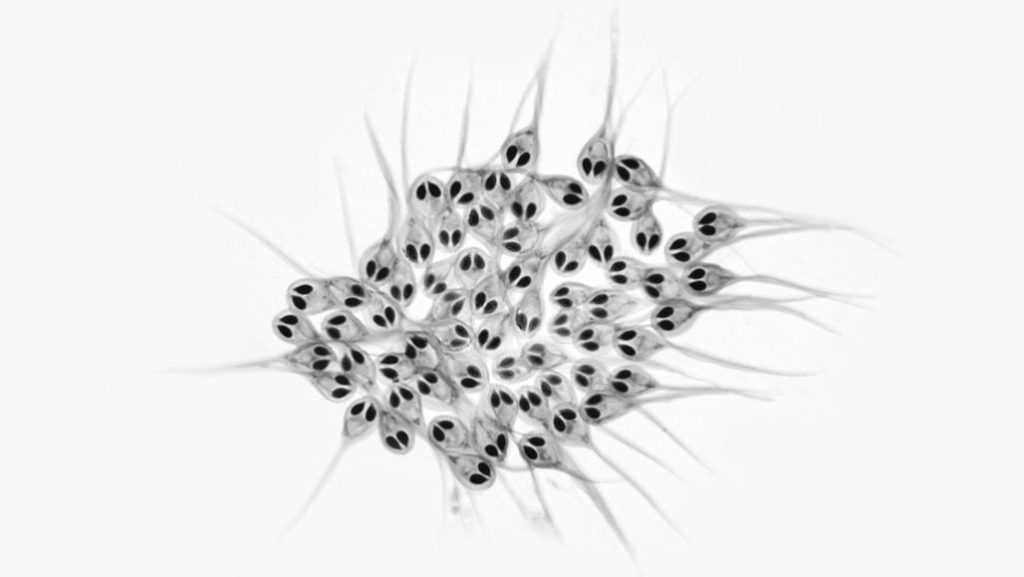A parasitic creature (distant cousin of the jellyfish) doesn’t have a mitochondrial genome — making it the first multicellular creature we know of that doesn’t need oxygen to survive.

Life is incredibly diverse. From the plant-like corals to the giant mammals and slithering lizards that inhabit the Earth, we’ve found a dazzling variety of creatures. But for all this variety, some things remained unchanged. All life as we know it needs water to survive. It’s all based on carbon — except for some experiments carried out in a lab — and it all needs oxygen. Or so we thought.
The common salmon parasite called Henneguya salminicola is well known to researchers. It causes white cysts that resemble tapioca in the fish muscles, which is why it is also called tapioca disease.
The parasite is a cnidarian belonging to the same phylum as corals, jellyfish and anemones — but it is a distant relative of jellyfish. Henneguya salminicola lives deep inside the fish for its entire lifecycle, which makes for some oxygen-poor conditions.
Researchers have suspected that it must have a special adaptation to allow it to survive when oxygen is scarce, but it wasn’t until Dayana Yahalomi of Tel Aviv University and her colleagues had a thorough look at it that they realized just how weird this adaptation is.
They used deep sequencing and fluorescence microscopy to analyze the parasitic creature, finding that it has completely lost its mitochondrial genome, as well as the capacity for aerobic respiration. Simply put, the creature can’t breathe oxygen.
“Our discovery shows that aerobic respiration, one of the most important metabolic pathways, is not ubiquitous among animals,” the study reads.
Life without oxygen

This is the first macroscopic creature known to not breathe oxygen. This simple trait has been with macroscopic life as we know it, ever since an Archaea swallowed a smaller bacterium, and somehow this worked out for both parties and the two stayed together. That is, the smaller bacteria became an organelle called mitochondria (the fabled powerhouse of the cell), an essential part of the breathing process.
Every cell in your body — and most bodies for that matter — contains large numbers of mitochondria. They break down oxygen to produce a molecule called adenosine triphosphate (ATP), which is then used to power cellular processes. Hence, the powerhouse of the cell thing.
Creatures that live in low-oxygen environments have special adaptations that enable them to survive, but no creature has been observed to completely lack this system.
This raises a number of intriguing questions. For starters where does it get its ATP from? A yet-untested theory is that they somehow leech it from the host, but this is yet to be confirmed. Secondly, how and why did the creature lose its mitochondria?
Researchers suspect that this is a case of genetic simplification, where the parasite simply shed unnecessary, cumbersome DNA as it evolved. This is consistent with the overall evolutionary trend observed in H. salminicola, devolving from a jellyfish-type creature to a much simpler parasite. But the fact that it just shed its mitochondria and ATP synthesis is extreme and very unusual.
Some single-celled creatures have developed mitochondria-type organelles for anaerobic metabolism. But never had this been identified in a multicellular creature — and even whether it was possible at all was debated.
The acquisition of mitochondria was a key step in the evolution of life on Earth. This is a possibility to study life as we didn’t know it before and understand how breathing really works. It’s also a nod that life can sometimes shift in different unexpected directions.
“Our discovery confirms that adaptation to an anaerobic environment is not unique to single-celled eukaryotes, but has also evolved in a multicellular, parasitic animal. Hence, H. salminicola provides an opportunity for understanding the evolutionary transition from an aerobic to an exclusive anaerobic metabolism,” the study concludes.
The study has been published in PNAS.


